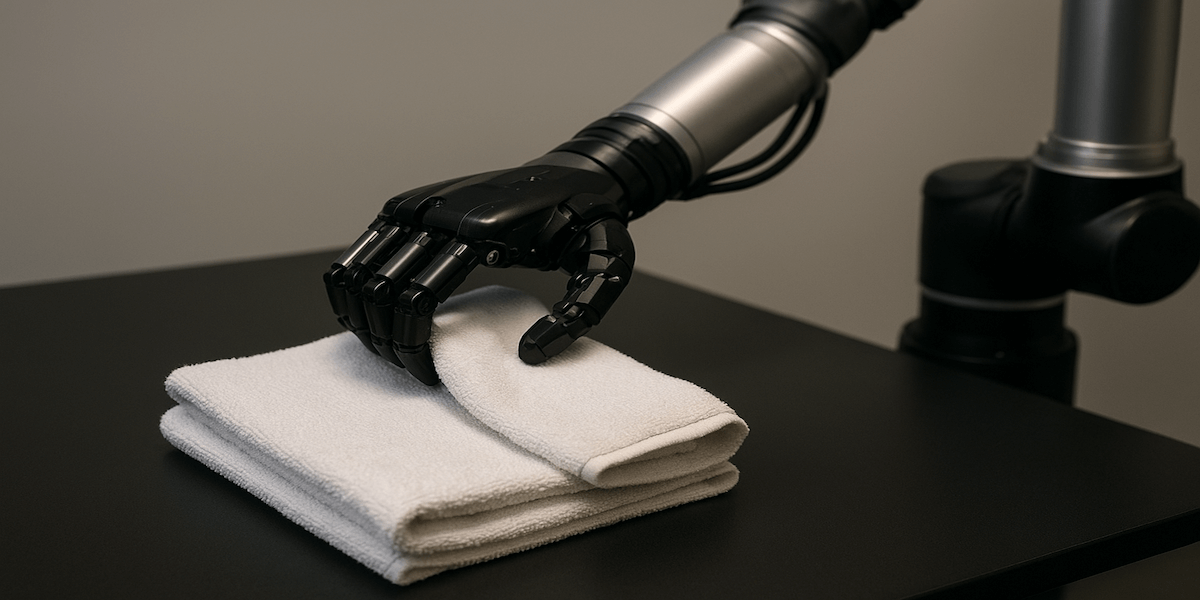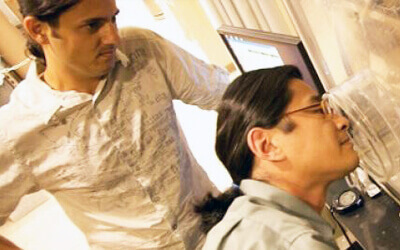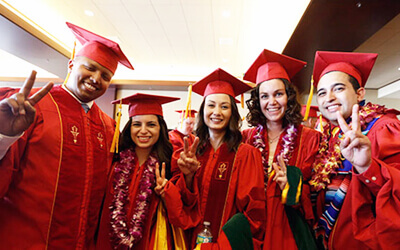
The ReWiND robot hand can self-teach complex tasks to itself, such as folding towels. (Image/ChatGPT)
Imagine a robot that can learn from its mistakes with no human input. It sounds like a scene out of a “Star Wars” movie, but a study conducted by a USC Viterbi team this spring showed it was possible. After just one video demonstration, the robotic arm eventually could complete complex tasks like folding towels or opening a specific trash bin.
This new approach allows robots to learn tasks faster and more efficiently and form the foundation for a world where a robot could do some simple household chores for you, step-by-step. Currently, humans must train the robot in what becomes a time-consuming and arduous process. Now, robots can train themselves from just watching the video repeatedly on the way to eventually completing its task.
“Every time the motors move, it gets feedback [from the video],” said Abrar Anwar, a fifth-year Ph.D. computer science student at the Thomas Lord Department of Computer Science.
This instant, automatic learning was demonstrated in a study called “ReWiND: Language-Guided Rewards Teach Robot Policies without New Demonstrations.” The paper was co-written by a student team co-led by Erdem Biyik, a USC Viterbi assistant professor of computer science and electrical and computer engineering, alongside Dr. Jesse Zhang and Jesse Thomason, a USC Viterbi assistant professor of computer science. Together, they developed a study that unlocks new potential in the world of robotic learning — and a bellwether for an exciting future.
“I could easily see house chores being done with robots,” Biyik said. “It’s not like you are telling the robot to cook a whole dish for you. But you are saying ‘dice the tomato,’ and then maybe next you say ‘Okay, now put the tomato in the pot.’”
The robotic lesson plan
Here’s how it works. First, a demonstration video is recorded of a robot doing a simple task, for example, picking up a sponge. This is different from a previous USC Viterbi study, which trained robots on videos of humans completing these tasks. When a robot is taught by a fellow robot, it can learn much more efficiently, making tasks easier and faster to complete.
“When we give a robot a robot video, the model is going to be [more] familiar with it,” Biyik said.
This demonstration video of the task — in this case, picking up a sponge — is recorded first. Then, the robot trainee starts working on the task it’s been assigned. This is where the magic lies: the robot learns every second. Even when moving itself towards the sponge, the robot communicates to itself that it is “succeeding,” and vice versa. The robot is programmed to give itself feedback based on the video, with no human intervention.

The ReWiND framework helps robots complete a variety of complex tasks. (Photo/courtesy of Erdem Biyik)
“As the robot approached the sponge, [it] would give some positive feedback, and then if it touched the sponge, more feedback — and then, if it grasped it, more positive feedback,” Biyik said.
The twist here that separates this study from any others is the titular “ReWiND” feature: videos are played in reverse, not just from beginning to end. This new process allows the robot to receive what they call “dense feedback,” meaning the robot not only learns more about the assigned task, but it also learns at a much quicker rate, based on only one video demonstration. This makes for a much faster and more dynamic learning process, because the robot learns what it’s doing wrong at the very beginning of a task and at every second in between, not just at the end.
“The reason why all this feedback matters is that whenever the robot is trying to learn things by itself, it does a lot of really stupid things: It crashes into the table, hits objects away when it’s supposed to pick it up, stuff like that,” Anwar said. “If [it] gives it dense feedback, like if the robot moves its hand away, [it] can give negative feedback for that.”
Thus, picking up a sponge is turned into a process with a very high number of small steps. Even moving the robotic arm in the right direction is ripe for positive or negative feedback. This feedback also needs to work regardless of the context, so your future robot chef could cook regardless of changes to variables like language.
“If we changed a little bit about the environment or the language we use, the robot is supposed to do the same thing,” said Yusen Luo, a recently graduated master’s computer science student. “For example, ‘close the window’ or ‘make the window close,’ should still work.”
The USC Viterbi team’s “ReWiND” paper has received significant acclaim since its publication. It won a “best paper” award at a workshop within the 2025 Robotics Science and Systems Conference in Los Angeles. It will be orally presented at the Conference at Robot Learning, a distinction bestowed on only 4.3% of the submitted papers.
But the accolades are just the beginning for ReWiND, whose teaching mechanics have huge potential in both the household — folding clothes, dicing tomatoes, and washing dishes — and in factories, too.
“You can apply this to many different kinds of industries,” Anwar said. “A lot of people have been looking at solving tasks in industrial problems. If you want to do manufacturing, it’s really hard normally to find out how to give feedback in those scenarios. But something like ReWiND, or a larger, scaled up version of ReWinD, can help give feedback if you have robots in-house.”
Published on October 1st, 2025
Last updated on October 1st, 2025







